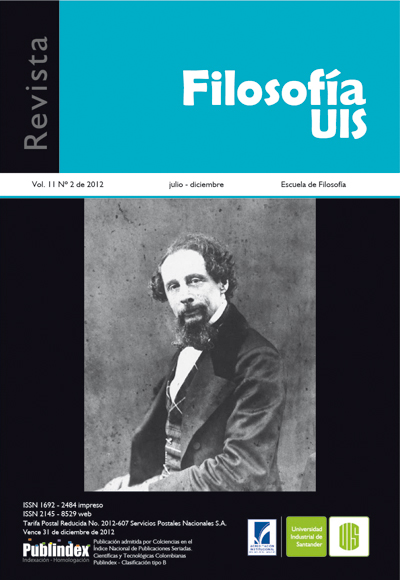Heidegger, reader of Plato: transition from aletheia through the cave’s myth
Published 2012-12-21
Keywords
- Plato,
- aletheia,
- truth,
- men,
- Western ontology
How to Cite
Copyright (c) 2012 Adriana Patricia Carreño Zúñiga

This work is licensed under a Creative Commons Attribution 4.0 International License.
Abstract
Heidegger back to the origin of the fundamental question repeatedly, this situation leads him to assert that the theming of the question of meaning, that is, the question of being, is directed towards of truth topic. In 1935, Heidegger checks his transit by Western ontology and writing framing under the title of “thinking history of being” (Seinsgeschichtlich). We intend to present Heidegger’s explanation of the passage or transit of truth in the origin of Greek thought as unconcealment (aletheia) and the platonic sense of truth as correspondence (omóiosis). The truth as aletheia, is the history section of the cave (which is the story of each men), a transformation by the “transit” between “seeing” (ὁρᾶν) and “visible” (νοεῖν), the transformation creates the new concept of Platonic ἰδέα: Heidegger calls this Er-blickenheit or truth as Homoiósis has since become adaequatio and then ‘agreement’. Study the theme of truth from an original reading by Martin Heidegger, aims noted the situation of the contemporary debate about the usual interpretation of Plato’s doctrine.
Downloads
References
- Friedländer, P. (1989). Platón: Verdad del ser y realidad de vida. Madrid: Tecnos.
- Heidegger, M. (1953). Doctrina de la Verdad según Platón. Santiago de Chile: Universidad de Chile.
- Heidegger, M. (1994). Conferencias y artículos. Barcelona: Ediciones del Serbal.
- Heidegger, M. (1997). Plato´s Sophist. Studies in Continental Thought. Indiana: Indiana University Press
- Heidegger, M. (2001). “Sobre la esencia de la verdad”. Hitos. Madrid: Alianza
- Heidegger, M. (2005). ¿Qué significa Pensar? Madrid: Trotta.
- Heidegger, M. (2007). De la esencia de la Verdad. Acerca del Mito de la Caverna y del Teeteto de Platón. Barcelona: Herder.
- Hölderlin, J. C. F. (1995). Poesía Completa. Barcelona: ediciones 29.
- Jaeger, W. (1997). La teología de los primeros filósofos griegos. México. Fondo de Cultura Económica.
- Kirk, Raven, Schofield. (2003). Los filósofos presocráticos. Madrid: Gredos.
- Platón (1992). “Timeo”. Diálogos VI. Madrid: Gredos.
- Platón (1999). “República”, “Sofista”. Diálogos IV. Madrid: Gredos.
- Xolocotzi, A. (2009). ”Fundación y Fundamentación. Aspectos del paso de aletheia a veritas en el pensar ontohistórico de Heidegger”. Memorias. Congreso internacional Martin Heidegger 120 años. Homenaje a Franco Volpi. Barranquilla: Universidad del Norte.
- CIBERGRAFÍA
- Heráclito (1983). Fr. 55, Hipólito, Ref. IX 9, 5,( B 101a) POLIB., XII 27. Disponible en internet: http://www.unizar.es/jsolana/files/fragmentosheraclitox.pdf
